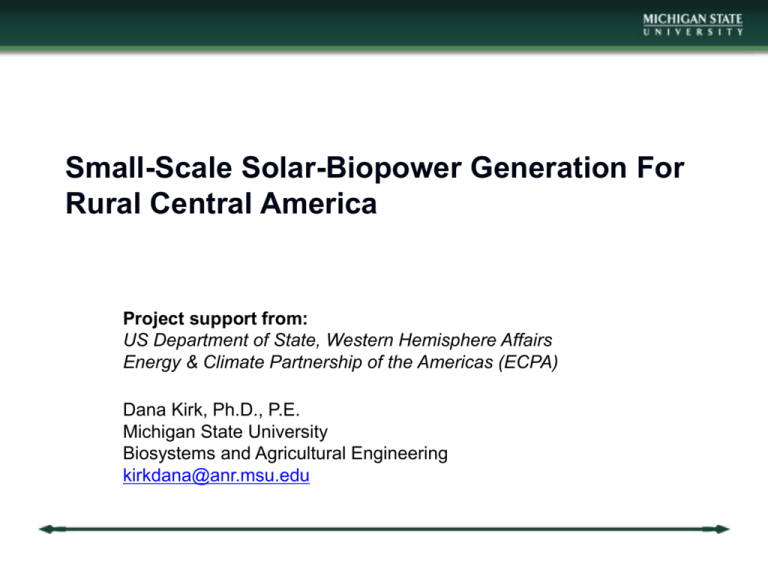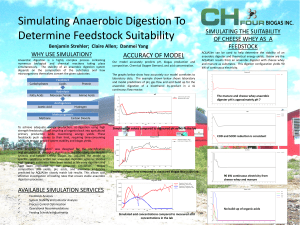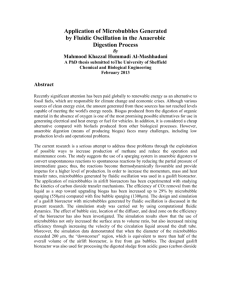Small-Scale - Michigan State University
advertisement

Small-Scale Solar-Biopower Generation For Rural Central America Project support from: US Department of State, Western Hemisphere Affairs Energy & Climate Partnership of the Americas (ECPA) Dana Kirk, Ph.D., P.E. Michigan State University Biosystems and Agricultural Engineering kirkdana@anr.msu.edu Project Partners Core Project Team PI – Ajit Srivastava, MSU BAE Co PI – Wei Liao, MSU BAE Co PI – Dawn Reinhold, MSU BAE Educational coordinator – Luke Reese, MSU BAE Project manager – Dana Kirk, MSU BAE Francisco Aguilar – UCR AE Daniel Baudrit – UCR AE Alberto Miranda – UCR AE Lorena Lorio – UCR Micro Lidieth Uribe – UCR Micro Project Objectives 1. Optimize local thermophilic anaerobic microbial consortia 2. Implement a solar-biopower generation system 3. Evaluate the technical and economic performance 4. Establish an outreach program in Central America Facts of solar energy Central America Advantages Theoretical: 1.76 x 105 TW striking Earth, Practical: 600 TW It is the cleanest energy source on the Earth. Solar energy reaching the earth is abundant. Disadvantages Sun does not shine consistently. Solar energy is a diffuse source. It is difficult to collect, covert, and store solar energy. From: http://www.global-greenhouse-warming.com/solar.html 5 Facts of Biogas Energy from Wastes Disadvantages Advantages A biological process Low efficiency of organic Reducing greenhouse gas emission Enhancing nutrient management Completely Stirred Tank Reactor (CSTR) matter degradation Difficulty of power generation for small-medium operations Anaerobic Sequence Batch Reactor (ASBR) Plug-flow digester 6 Agricultural residues available in Costa Rica Residues Total amount (metric ton dry matter per year) 2006 Cattle manure 1,530,000 Swine manure 95,000 Banana residues Coffee residues Sugarcane bagasse Pineapple residues 158,000 (pulp) 251,000 (husk) 25,000 1,290,000 6,351,000 Current treatment practices Projection 2012 1,679,900 Only 20% of producers treat wastes, dried and composted 110,000 0.68% for production of energy and rest in agriculture, fertilizer (45.5%) food animal (53.1%) or other uses (0.7%). 132,000 Not used as energy source,100% discarded or composted organic (pulp) 262,000 Pulp is used for composting, and husk is used (husk) 26,300 for combustion 1,518,200 95.3% dried and used as combustion, 4.7% non energetic 8,452,000 Combusted and soil improvement More than 600 MW electricity per year could be potentially generated from this amount of waste streams through anaerobic digestion technology. 7 Solar-biopower concept Integrating wastes utilization with solar and biological technologies will create a novel self-sustainable clean energy generations system for small-medium scale operations Bioenergy Animal Manure Other Organic Wastes Solar Energy Anaerobic Digestion Posttreatment Fertilizers Reduced GHG Clean Water Solar-biopower concept Benefits of system integration Overcome the disadvantages of individual technologies Unsteady energy flow for solar power generation Low efficiency of mesophilic anaerobic digestion on degradation of organic matter Higher energy requirement of thermophilic aerobic digestion Provide sufficient and stable energy for small-medium sized rural community Solar energy utilization Improved efficiency of anaerobic digestion on degradation of organic matter Biogas energy as chemical storage – steady energy flow 9 Mass balance Predicted mass balance for the integrated solar-bio system on 1,000 kg of mixed sludge and food wastes Boiler Biogas production from anaerobic treatment Bioenergy Amount: 684 MJ/day Methane: 18,000 L/day Mixture of feedstocks: Thermophilic CSTR Total amount: 1,000 kg/day Total solid: 10% COD: 90 g/kg Reaction temp.: 50°C Retention time: 15 days COD reduction: 50% Total solid reduction:40% Generator Liquid effluent Amount: 595 kg/day Total solid: 10 g/kg effluent COD: 45 g/kg effluent To wetland Solid residue accumulated from the CSTR Amount: 360 kg/day wet solid Dry matter: 15% Generating 66 kWh electricity per day Producing 5 gasoline gallon equivalent (GGE) renewable fuel per day a. b. The calculation of mass balance was based on the expected results that will be achieved by this project. A kg COD destroyed produces 350 L methane gas. 10 Solar-biopower system Power unit Solar unit Bioreactor Post-treatment 11 Construction site Solar Bio-Reactor Site Fabio Baudrit Experiment Station Major system components 16 – 2 m2 flat-plate solar collector with support 22 m3 anaerobic digester 50 m3 gas bag 2 – 10 kW electric generators 4 – 144 m2 wetland/sand filter cells Solar Bio-Reactor Sand Filter / Wetland Solar thermal system Solar collectors, hot water tank (white), & hot water storage (green) Anaerobic digester Poly tank anaerobic digester Official ribbon (digester in background clad in tin) Field engineering Feedstock & digestate handling Digestate solid-liquid separator Feedstock grinder, auger & mix tank (pump not shown) Biogas storage Gas bag, foam interceptor, & scrubber Biogas sampling Full gas bag, May 2, 2013 Sand filter & wetlands Sand filter 1 Vertical wetland (sand filter 2) Surface wetland 1 Surface wetland 2 Solar-biopower system performance Feedstock: Beef manure (950+ kg/d) Food waste Chicken litter (20 kg/d) Temperature: Currently 45oC±2oC Target 50oC±1oC Biogas production: ≈20 m3/d Biogas quality: 60+% CH4 Volatile solids destruction: 39% to 44% Water reclamation Organic waste Original waste stream May 2013 Anaerobic digester The effluent from solarbioreactor Sand filter No. 1 Sand filter No. 2 The water from the 1st cell of posttreatment Reclaimed water The water from the 2nd cell of posttreatment Outcomes to date Pilot system Biogas production at 70% of goal Biogas quality and solids destruction have achieved goals Install biogas flow meter Connect electrical generators to the experiment station power Begin sand filter/wetland research Bioenergy support lab at UCR – capable of carrying out BMP’s and other analysis Utilization of local manufacturing – coffee equipment & solar panels Study abroad “Ecological Engineering in the Tropics” completed in December of 2012 Next steps Finalize microbial consortia papers Continue to operate pilot system until Sept. 2014 Operate portable unit at second location – wastewater or food processor Complete economic and policy evaluation 2013 study abroad planned for December Expand bioenergy capabilities to address commercial needs Other announcements August 13, 2013 – MSU Waste to Resource Field Day Highlights: South Campus Anaerobic Digester (500 kW from 130 cows) Research digester, compost facility, student organic farm, recycling center, power plant, ADREC For more information go to :http://events.anr.msu.edu/adrec/ October 15 to 17 – Anaerobic Digester Operator Training (East Lansing, MI) Highlights System commissioning Maintaining biological health Safety Operational troubleshooting For information contact kirkdana@anr.msu.edu Questions? Dana M Kirk, Ph.D., P.E. Biosystems and Agricultural Engineering Anaerobic Digestion Research and Education Center E: kirkdana@anr.msu.edu P: 517.432.6530







